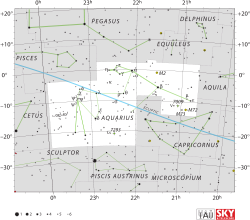89 Aquarii
| Observation data Epoch J2000 Equinox J2000 | |
|---|---|
| Constellation | Aquarius |
| Right ascension | 23h 09m 54.89736s[1] |
| Declination | –22° 27′ 27.4192″[1] |
| Apparent magnitude (V) | +4.69[2] |
| Characteristics | |
| Spectral type | G3 II + A2 V[3] |
| U−B color index | +0.39[2] |
| B−V color index | +0.65[2] |
| Astrometry | |
| Radial velocity (Rv) | -4.8[4] km/s |
| Proper motion (μ) | RA: +32.61[1] mas/yr Dec.: –9.76[1] mas/yr |
| Parallax (π) | 6.47 ± 0.68 mas[1] |
| Distance | approx. 500 ly (approx. 150 pc) |
| Absolute magnitude (MV) | 0.1/1.5[5] |
| Details | |
| 89 Aqr A | |
| Mass | 2.9[5] M☉ |
| Surface gravity (log g) | 3.62[6] cgs |
| Temperature | 5,640[6] K |
| Metallicity [Fe/H] | +0.27[6] dex |
| Age | 320[5] Myr |
| 89 Aqr B | |
| Mass | 2.0[5] M☉ |
| Temperature | 8,912[5] K |
| Other designations | |
| 89 Aqr A: HD 218640. | |
| 89 Aqr B: HD 218641. | |
| Database references | |
| SIMBAD | data |
89 Aquarii (abbreviated 89 Aqr) is a binary star[3] system in the equatorial constellation of Aquarius. 89 Aquarii is the Flamsteed designation, though it also bears the Bayer designation c3 Aquarii.[8] The apparent visual magnitude of +4.69[2] is bright enough to be seen with the naked eye. Its distance from Earth is roughly 500 light-years (150 pc), based upon parallax measurements with an 11% margin of error.[1]
The primary component of this system has a magnitude of 5.27 and a stellar classification of G3 II, which suggests this is an evolved star in the bright giant stage. The companion is an A-type main sequence star with a stellar classification of A2 V.[3] As of 2010, it is located at an angular separation of 0.1843 arcseconds along a position angle of 135.1°.[9] They orbit each other with an estimated period of 201 years and a semimajor axis of 0.45 arcseconds.[5]
References
[edit]- ^ a b c d e f van Leeuwen, F. (November 2007), "Validation of the new Hipparcos reduction", Astronomy and Astrophysics, 474 (2): 653–664, arXiv:0708.1752, Bibcode:2007A&A...474..653V, doi:10.1051/0004-6361:20078357, S2CID 18759600.
- ^ a b c d Nicolet, B. (1978), "Photoelectric photometric Catalogue of homogeneous measurements in the UBV System", Astronomy and Astrophysics Supplement Series, 34: 1–49, Bibcode:1978A&AS...34....1N.
- ^ a b c Eggleton, P. P.; Tokovinin, A. A. (September 2008), "A catalogue of multiplicity among bright stellar systems", Monthly Notices of the Royal Astronomical Society, 389 (2): 869–879, arXiv:0806.2878, Bibcode:2008MNRAS.389..869E, doi:10.1111/j.1365-2966.2008.13596.x, S2CID 14878976.
- ^ Wilson, R. E. (1953), "General Catalogue of Stellar Radial Velocities", Carnegie Institute Washington D.C. Publication, Carnegie Institute of Washington, D.C., Bibcode:1953GCRV..C......0W.
- ^ a b c d e f Parsons, Sidney B. (May 2004), "New and Confirmed Triple Systems with Luminous Cool Primaries and Hot Companions", The Astronomical Journal, 127 (5): 2915–2930, Bibcode:2004AJ....127.2915P, doi:10.1086/383546.
- ^ a b c McWilliam, Andrew (December 1990), "High-resolution spectroscopic survey of 671 GK giants. I - Stellar atmosphere parameters and abundances", Astrophysical Journal Supplement Series, 74: 1075–1128, Bibcode:1990ApJS...74.1075M, doi:10.1086/191527.
- ^ "* 89 Aqr". SIMBAD. Centre de données astronomiques de Strasbourg. Retrieved 2012-07-13.
- ^ [1] database record, HD-DM-GC-HR-HIP-Bayer-Flamsteed Cross Index, N. D. Kostjuk, Institute of Astronomy of Russian Academy of Sciences, 2002; CDS ID IV/27A.
- ^ Tokovinin, A.; et al. (December 2010), "High-Resolution Imaging at the SOAR Telescope", Publications of the Astronomical Society of the Pacific, 122 (898): 1483–1494, arXiv:1010.4176, Bibcode:2010PASP..122.1483T, doi:10.1086/657903, S2CID 26826524.

